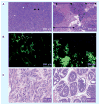Nanoparticle-mediated hyperthermia in cancer therapy
- PMID: 22506095
- PMCID: PMC3323111
- DOI: 10.4155/tde.11.72
Nanoparticle-mediated hyperthermia in cancer therapy
Abstract
A small rise in tumor temperature (hyperthermia) makes cancer cells more susceptible to radiation and chemotherapy. The means of achieving this is not trivial, and traditional methods have certain drawbacks. Loading tumors with systematically asministered energy-transducing nanoparticles can circumvent several of the obstacles to achieve tumor hyperthermia. However, nanoparticles also face unique challenges prior to clinical implementation. This article summarizes the state-of-the-art current technology and discusses the advantages and challenges of the three major nanoparticle formulations in focus: gold nanoshells and nanorods, superparamagnetic iron oxide particles and carbon nanotubes.
Figures



References
-
- Friedenthal E, Mendecki J, Botstein C, Sterzer F, Nowogrodzki M, Paglione R. Some practical considerations for the use of localized hyperthermia in the treatment of cancer. J Microw Power. 1981;16(2):199–204. - PubMed
-
- Lele PP. Induction of deep, local hyperthermia by ultrasound and electromagnetic fields: problems and choices. Radiat Environ Biophys. 1980;17(3):205–217. - PubMed
-
- Magin RL, Johnson RK. Effects of local tumor hyperthermia on the growth of solid mouse tumors. Cancer Res. 1979;39(11):4534–4539. - PubMed
-
- Kim JH, Hahn EW, Ahmed SA. Combination hyperthermia and radiation therapy for malignant melanoma. Cancer. 1982;50(3):478–482. - PubMed
Publication types
MeSH terms
Substances
Grants and funding
LinkOut - more resources
Full Text Sources
Other Literature Sources
